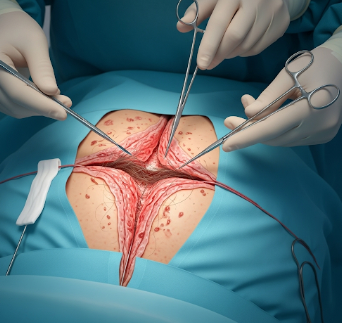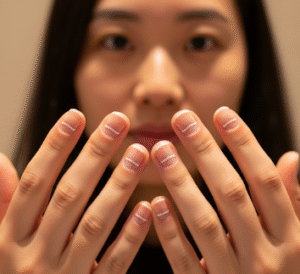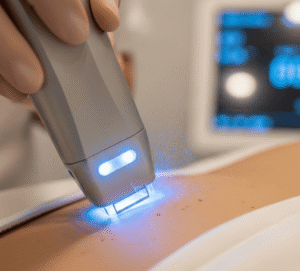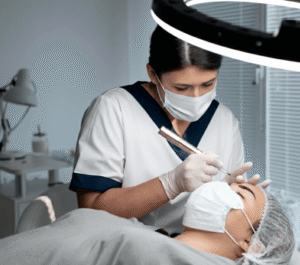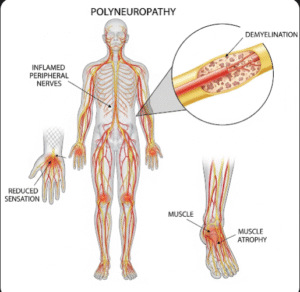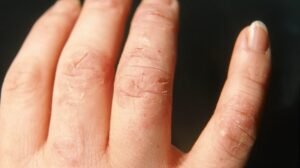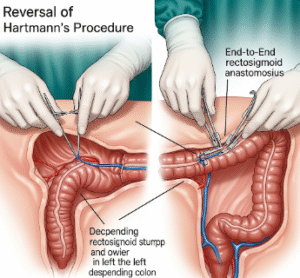Overview
Surgery for pilonidal sinus is a medical procedure aimed at treating a chronic or recurrent infection of the skin and subcutaneous tissue near the tailbone (sacrococcygeal area). A pilonidal sinus is a small tunnel or cavity in the skin that can become infected and filled with pus, hair, and debris, leading to pain, swelling, and sometimes abscess formation.
In Korea, this surgery is performed in advanced colorectal and general surgery centers, using modern minimally invasive or flap techniques to ensure effective treatment, low recurrence rates, and faster recovery.
What is Surgery for Pilonidal Sinus?
The surgical procedure involves removing the sinus tract, infected tissue, and debris, followed by closure of the wound or leaving it open to heal naturally depending on the technique.
Common surgical approaches include:
- ✦ Excision with primary closure: the sinus tract is removed, and the wound is sutured for faster healing.
- ➤ Excision with secondary intention (open wound healing): the wound is left open to drain and heal naturally, reducing recurrence risk.
- ✦ Flap procedures (e.g., Limberg flap, Karydakis flap): tissue flaps are used to cover the defect, especially in complex or recurrent cases.
- ➤ Minimally invasive techniques (pit picking, endoscopic): small incisions and removal of only infected tissue to minimize trauma and recovery time.
The main goal is to eliminate infection, relieve pain, prevent recurrence, and restore normal function.
What are the Benefits?
Surgery for pilonidal sinus provides several advantages:
✅ Relieves pain, swelling, and recurrent infections.
➤ Reduces risk of abscess formation and systemic infection.
✦ Minimally invasive techniques minimize tissue damage, scarring, and recovery time.
➤ Flap procedures are particularly effective in preventing recurrence.
✅ Restores comfort and mobility, allowing normal sitting and activity.
✦ High success rate with proper surgical technique and post-operative care.
Procedure Details
1) How should I prepare for Surgery for Pilonidal Sinus?
Preparation steps include:
- ✦ Medical evaluation: review medical history, allergies, medications, and prior pilonidal surgery if any.
- ➤ Diagnostic imaging: sometimes ultrasound or MRI to determine sinus tract extent.
- ✦ Medication adjustments: stop anticoagulants or medications affecting healing as advised.
- ➤ Hygiene: clean the sacrococcygeal area thoroughly to reduce infection risk.
- ✦ Consent and counseling: discussion of procedure type, anesthesia, risks, benefits, and recovery expectations.
- ➤ Fasting instructions: required if general or spinal anesthesia is planned.
2) What happens during the procedure Surgery for Pilonidal Sinus?
The procedure is performed under local, spinal, or general anesthesia:
➤ Step 1: Patient is positioned prone, with the surgical site sterilized.
✦ Step 2: The sinus tract and surrounding infected tissue are carefully excised.
➤ Step 3: If a flap procedure is chosen, tissue is mobilized to cover the defect and sutured.
✦ Step 4: Hemostasis is ensured, and the wound is cleaned.
➤ Step 5: The incision may be closed primarily or left open for secondary healing, depending on the approach.
✦ Step 6: Sterile dressing is applied, and patient is monitored during recovery.
Minimally invasive techniques in Korea reduce tissue trauma, minimize pain, and allow faster return to daily activities.
3) What happens after Surgery for Pilonidal Sinus?
Postoperative care includes:
- ✦ Monitoring: watch for bleeding, swelling, or infection.
- ➤ Pain management: oral analgesics or anti-inflammatory medications as prescribed.
- ✦ Wound care: keep the area clean and dry; follow dressing change instructions.
- ➤ Activity guidance: avoid prolonged sitting, heavy lifting, or strenuous activity for a few weeks.
- ✦ Follow-up visits: assessment of healing, suture removal if necessary, and monitoring for recurrence.
- ➤ Hair and hygiene maintenance: keeping the area free of hair and debris to prevent recurrence.
Healing varies depending on the technique: primary closure typically heals in 2–3 weeks, while open or flap techniques may take 4–6 weeks.
Risks / Benefits
Potential Risks:
- ✦ Infection or abscess formation at the surgical site.
- ➤ Bleeding or hematoma.
- ✦ Delayed wound healing or wound dehiscence.
- ➤ Recurrence of pilonidal sinus if excision is incomplete.
- ✦ Rare complications: injury to surrounding tissue or scarring.
Benefits:
- ✅ Eliminates chronic infection and pain.
- ✅ Prevents future abscess formation and systemic infection.
- ✅ Minimally invasive options reduce pain, scarring, and recovery time.
- ✅ Flap procedures offer low recurrence rates.
- ✅ Restores comfort, mobility, and quality of life.
Recovery and Outlook
Recovery after pilonidal sinus surgery generally includes:
- ➤ Hospital stay: outpatient or 1–2 days depending on procedure complexity.
- ✦ Pain management: mild to moderate discomfort controlled with medication.
- ➤ Wound care: essential to prevent infection; regular dressing changes advised.
- ✦ Activity: avoid prolonged sitting and strenuous activity for 2–4 weeks.
- ➤ Long-term outcome: most patients experience complete resolution of symptoms, low recurrence rates, and restored comfort and mobility.
When To Call the Doctor
Contact your healthcare provider if you notice:
⚠ Severe pain, swelling, or redness not relieved by medication.
⚠ Pus, foul odor, or other signs of infection.
⚠ Excessive bleeding or wound opening.
⚠ Difficulty sitting or walking beyond expected recovery period.
⚠ Recurrence of sinus or new abscess formation.
Best Korea Option / Process
Korea provides world-class surgery for pilonidal sinus with:
- ✦ Expert colorectal and general surgeons skilled in excision, flap, and minimally invasive techniques.
- ➤ Advanced imaging and surgical planning for precise treatment.
- ✦ Minimally invasive and flap procedures for faster recovery and reduced recurrence.
- ➤ Comprehensive pre- and post-operative care, including wound management, infection prevention, and follow-up.
- ✦ Safe and effective procedures for both international and domestic patients.
- ➤ Multidisciplinary support including nursing, physiotherapy, and counseling for optimal recovery.
Korea ensures patients receive safe, precise, and effective treatment for pilonidal sinus with minimal complications and excellent long-term outcomes.
Highlights of Surgery for Pilonidal Sinus in Korea
- ✅ Minimally invasive and flap techniques for effective treatment.
- ➤ Rapid relief of pain, infection, and swelling.
- ✦ Reduced hospital stay and faster recovery.
- ➤ Low recurrence rates with expert surgical care.
- ✅ Comprehensive pre- and post-operative care for optimal outcomes.

